A Theoretical Calculation Method of Ground Settlement Based on a Groundwater Seepage and Drainage Model in Tunnel Engineering
Abstract
1. Introduction
2. Seepage and Drainage Mechanism of a Tunnel Aquifer
2.1. Tunnel Seepage Dewatering Funnel
2.2. Seepage Equation of Phreatic Tunnel
3. Dewatering Funnel Curve Equation
4. Calculation of Ground Settlement Caused by Seepage
4.1. Problem Description
4.2. Calculation Method of Ground Settlement Caused by Seepage
5. Case Study
6. Conclusions
Author Contributions
Funding
Institutional Review Board Statement
Informed Consent Statement
Data Availability Statement
Acknowledgments
Conflicts of Interest
References
- Li, K.; Guo, Z.; Wang, L.; Jiang, H. Effect of seepage flow on shields number around a fixed and sagging pipeline. Ocean Eng. 2019, 172, 487–500. [Google Scholar] [CrossRef]
- Zareifard, M. An analytical solution for design of pressure tunnels considering seepage loads. Appl. Math. Model. 2018, 62, 62–85. [Google Scholar] [CrossRef]
- Peck, R. Deep Excavation and Tunneling in Soft Ground. In Proceedings of the 7th International Conference Soil Mechanics and Foundation Engineering, Mexico City, Mexico, 21 August 1969; State of the Art Volume. Sociedad Mexicana de Mecánica: Mexico City, Mexico, 1969; pp. 225–290. [Google Scholar]
- Attewell, P.B.; Farmer, I.W. Ground deformations resulting from shield tunnelling in London Clay. Can. Geotech. J. 1974, 11, 380–395. [Google Scholar] [CrossRef]
- O’Reilly, M.P.; News, B.M. Settlements above tunnels in the United Kingdom their magnitude and prediction. In Proceedings of the Tunnelling’82 Symposium, Brighton, UK, 7–11 June 1982; Institution of Mining and Metallurgy: London, UK, 1982. [Google Scholar]
- Sagaseta, C. Analysis of undrained soil deformation due to ground loss. Géotechnique 1987, 37, 301–320. [Google Scholar] [CrossRef]
- Rankin, W.J. Ground movement resulting from urban tunnelling: Predictions and effects. In Proceedings of the 23rd Annual Conference on the Engineering Group of the Geological Society, London, UK, 1 January 1988; Nottingham University: Nottingham, UK, 1988. [Google Scholar]
- Mair, R.J.; Taylor, R.N.; Bracegirdle, A. Subsurface settlement profiles above tunnels in clays. Géotechnique 1993, 43, 315–320. [Google Scholar] [CrossRef]
- Loganathan, N.; Poulos, H.G. Analytical prediction for tunneling induced ground movement in clays. ASCE J. Geotech. Geoenviron. Eng. 1998, 124, 846–856. [Google Scholar] [CrossRef]
- Lee, C.J.; Wu, B.R.; Chiou, S.Y. Soil movements around a tunnel in soft soils. Proc. Natl. Sci. Counc. Part A Phys. Sci. Eng. 1999, 23, 235–247. [Google Scholar]
- Marshall, A.M.; Farrell, R.; Klar, A.; Mair, R.J. Tunnels in sands: The effect of size, depth and volume loss on greenfield displacements. Géotechnique 2012, 62, 385–399. [Google Scholar] [CrossRef]
- Attewell, P.B.; Yeates, J.; Selby, A.R. Ground deformation and strain equations. In Soil Movements Induced by Tunneling and Their Effects on Pipeline and Structures; Glasgow: Blackie, AB, Canada, 1986; pp. 53–66. [Google Scholar]
- O’Reilly, M.P.; Mair, R.J.; Alderman, G.H. Long-term settlements over Tunnels. An eleven-year study at grimsby. In Tunnelling’91 London; Institution of Mining and Metallurgy: London, UK, 1991; pp. 55–64. [Google Scholar]
- Mair, R.J.; Potts, D.M.; Hight, D.W. Finite element analyses of settlements around a tunnel in soft ground. In Contractor Report; Transport and Road Research Laboratory: Berkshire, UK, 1991. [Google Scholar]
- Bowers, K.H.; Hiller, D.M.; New, B.M. Ground movement over three years at the Heathrow Express Trial Tunnel. In Geotechnical Aspects of Underground Construction in Soft Ground; Taylor, M., Ed.; Routledge: London, UK, 1996; pp. 647–652. [Google Scholar]
- Anagnostou, G. Urban tunnelling in water bearing ground—Common problems and soil mechanical analysis methods. In Proceedings of the Planning and Engineering for the Cities of Tomorrow, Second International Conference on Soil Structure Interaction in Urban Civil Engineering, Zurich, Switzerland, 7–8 March 2002; pp. 233–240. [Google Scholar]
- Jallow, A.; Ou, C.; Lim, A. Three-dimensional numerical study of long-term settlement induced in shield tunneling. Tunn. Undergr. Space Technol. 2019, 88, 221–236. [Google Scholar] [CrossRef]
- Kwong, A.K.L.; Ng, C.C.W.; Schwob, A. Control of settlement and volume loss induced by tunneling under recently reclaimed land. Undergr. Space 2019, 4, 289–301. [Google Scholar] [CrossRef]
- Miliziano, S.; De Lillis, A. Predicted and observed settlements induced by the mechanized tunnel excavation of metro line C near S. Giovanni station in Rome. Tunn. Undergr. Space Technol. 2019, 86, 236–246. [Google Scholar] [CrossRef]
- Klotoé, C.H.; Bourgeois, E. Three dimensional finite element analysis of the influence of the umbrella arch on the settlements induced by shallow tunneling. Comput. Geotech. 2019, 110, 114–121. [Google Scholar] [CrossRef]
- Moghaddasi, M.; Noorian-Bidgoli, M. ICA-ANN, ANN and multiple regression models for prediction of surface settlement caused by tunneling. Tunn. Undergr. Space Technol. 2018, 79, 197–209. [Google Scholar] [CrossRef]
- Ahangari, K.; Moeinossadat, S.R.; Behnia, D. Estimation of tunnelling-induced settlement by modern intelligent methods. Soils Found. 2015, 55, 737–748. [Google Scholar] [CrossRef]
- Suwansawat, S.; Einstein, H.H. Artificial neural networks for predicting the maximum surface settlement caused by EPB shield tunneling. Tunn. Undergr. Space Technol. 2006, 21, 133–150. [Google Scholar] [CrossRef]
- Pourtaghi, A.; Lotfollahi-Yaghin, M.A. Wavenet ability assessment in comparison to ANN for predicting the maximum surface settlement caused by tunneling. Tunn. Undergr. Space Technol. 2012, 28, 257–271. [Google Scholar] [CrossRef]
- Ni, P.; Mangalathu, S. Fragility analysis of gray iron pipelines subjected to tunneling induced ground settlement. Tunn. Undergr. Space Technol. 2018, 76, 133–144. [Google Scholar] [CrossRef]
- Lee, K.M.; Ji, H.W.; Shen, C.K.; Liu, J.H.; Bai, T.H. Ground response to the construction of Shanghai metro tunnel-line 2. Soils Found. 1999, 39, 113–134. [Google Scholar] [CrossRef]
- Zheng, G.; Tong, J.; Zhang, T.; Wang, R.; Fan, Q.; Sun, J.; Diao, Y. Experimental study on surface settlements induced by sequential excavation of two parallel tunnels in drained granular soil. Tunn. Undergr. Space Technol. 2020, 98, 103347. [Google Scholar] [CrossRef]
- Cheng, P.; Zhao, L.; Luo, Z.; Li, L.; Li, Q.; Deng, X.; Peng, W. Analytical solution for the limiting drainage of a mountain tunnel based on area-well theory. Tunn. Undergr. Space Technol. 2019, 84, 22–30. [Google Scholar] [CrossRef]
- Weng, X.; Sun, Y.; Zhang, Y.; Niu, H.; Liu, X.; Dong, Y. Physical modeling of wetting-induced collapse of shield tunneling in loess strata. Tunn. Undergr. Space Technol. 2019, 90, 208–219. [Google Scholar] [CrossRef]
- Yang, F.; Zhang, C.; Zhou, H.; Liu, N.; Zhang, Y.; Azhar, M.U.; Dai, F. The long-term safety of a deeply buried soft rock tunnel lining under inside-to-outside seepage conditions. Tunn. Undergr. Space Technol. 2017, 67, 132–146. [Google Scholar] [CrossRef]
- Perazzelli, P.; Leone, T.; Anagnostou, G. Tunnel face stability under seepage flow conditions. Tunn. Undergr. Space Technol. 2014, 43, 459–469. [Google Scholar] [CrossRef]
- Perazzelli, P.; Cimbali, G.; Anagnostou, G. Stability under seepage flow conditions of a tunnel face reinforced by bolts. Procedia Eng. 2017, 191, 215–224. [Google Scholar] [CrossRef]
- Sahoo, J.P.; Kumar, B. Support pressure for stability of circular tunnels driven in granular soil under water table. Comput. Geotech. 2019, 109, 58–68. [Google Scholar] [CrossRef]
- Chen, R.; Yin, X.; Tang, L.; Chen, Y. Centrifugal model tests on face failure of earth pressure balance shield induced by steady state seepage in saturated sandy silt ground. Tunn. Undergr. Space Technol. 2018, 81, 315–325. [Google Scholar] [CrossRef]
- Lü, X.; Zhou, Y.; Huang, M.; Zeng, S. Experimental study of the face stability of shield tunnel in sands under seepage condition. Tunn. Undergr. Space Technol. 2018, 74, 195–205. [Google Scholar] [CrossRef]
- Pan, Q.; Dias, D. Three dimensional face stability of a tunnel in weak rock masses subjected to seepage forces. Tunn. Undergr. Space Technol. 2018, 71, 555–566. [Google Scholar] [CrossRef]
- Jiang, Z. Interaction between tunnel engineering and water environment. Chin. J. Rock Mech. Eng. 2005, 24, 121–127. (In Chinese) [Google Scholar]
- Yoo, C. Ground settlement during tunneling in groundwater drawdown environment-Influencing factors. Undergr. Space 2018, 1, 20–29. [Google Scholar] [CrossRef]
- Zhang, P.; Chen, R.P.; Wu, H.N.; Liu, Y. Ground settlement induced by tunneling crossing interface of water-bearing mixed ground: A lesson from Changsha, China. Tunn. Undergr. Space Technol. 2020, 96, 103224. [Google Scholar] [CrossRef]
- Yoo, C.; Lee, Y.; Kim, S.H.; Kim, H.T. Tunnelling-induced ground settlements in a groundwater drawdown environment—A case history. Tunn. Undergr. Space Technol. 2012, 29, 69–77. [Google Scholar] [CrossRef]
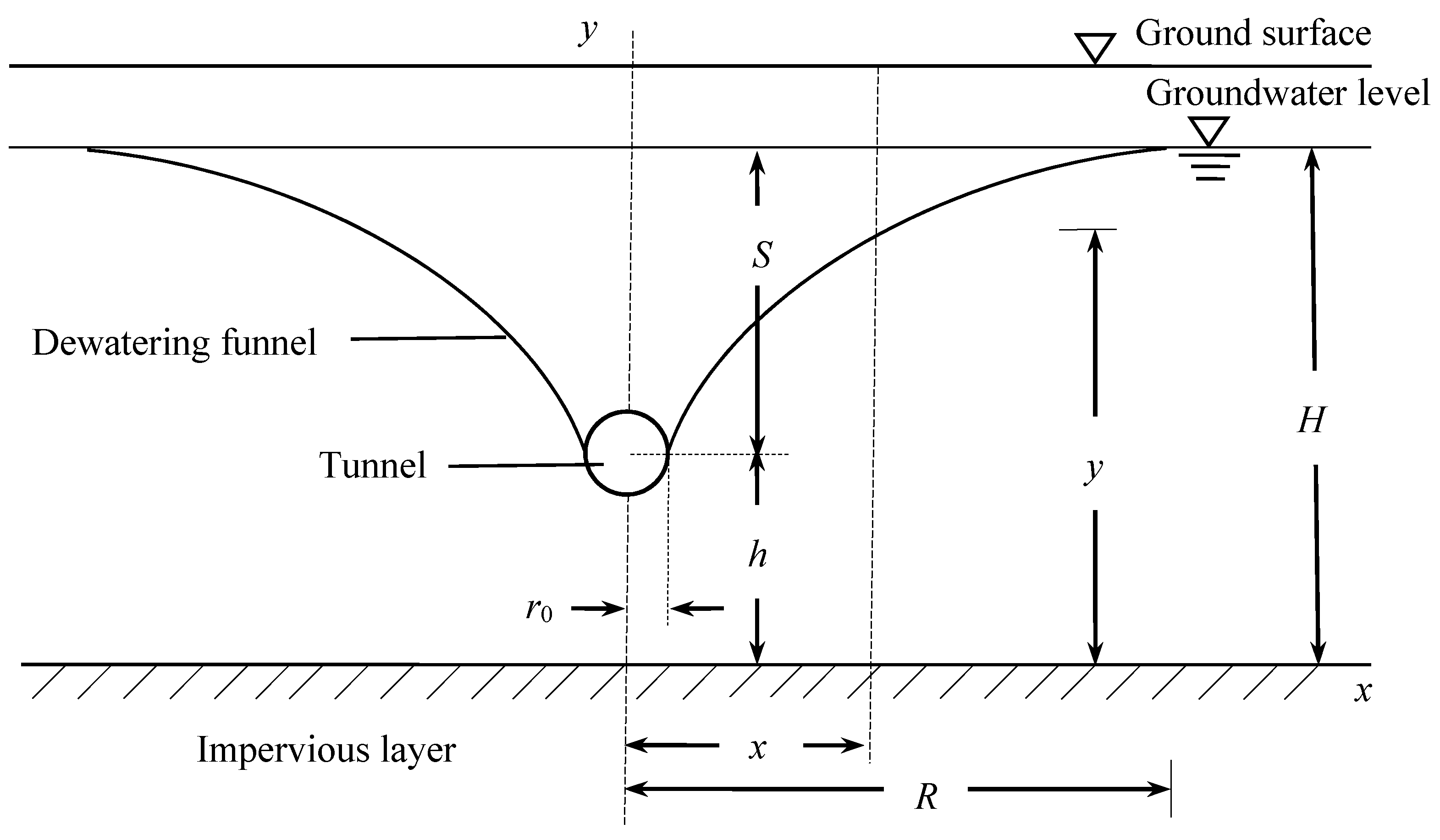
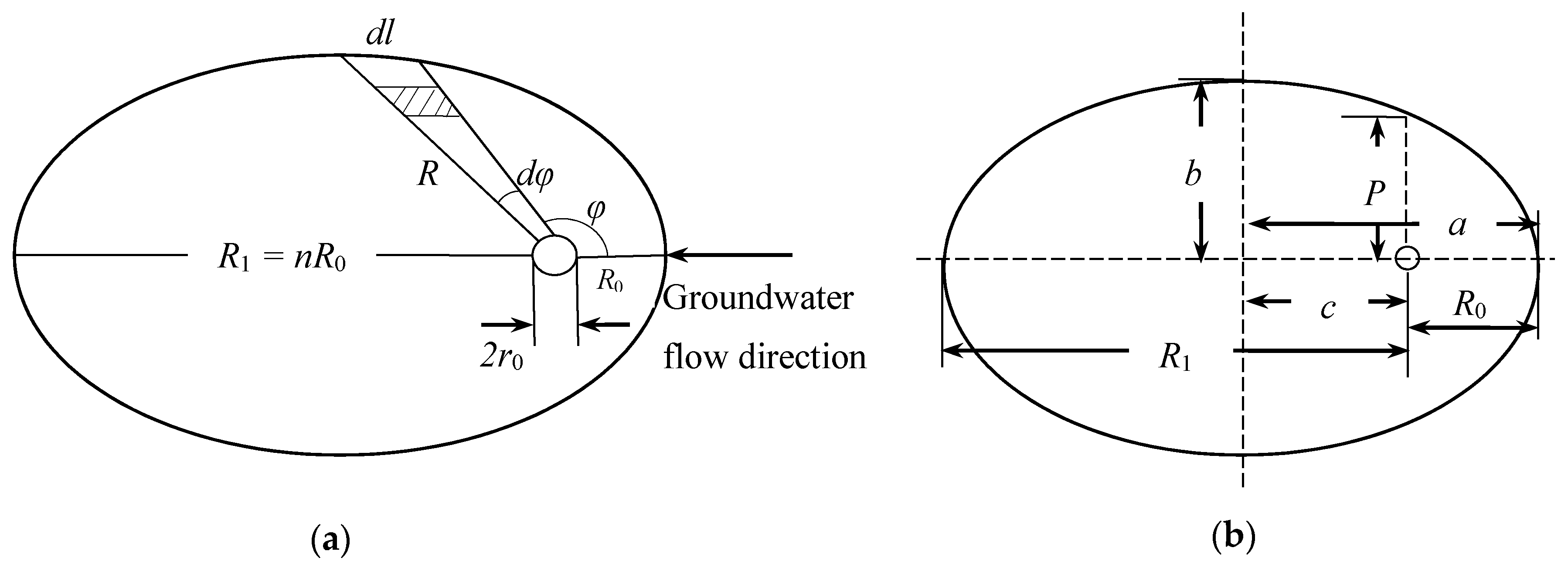
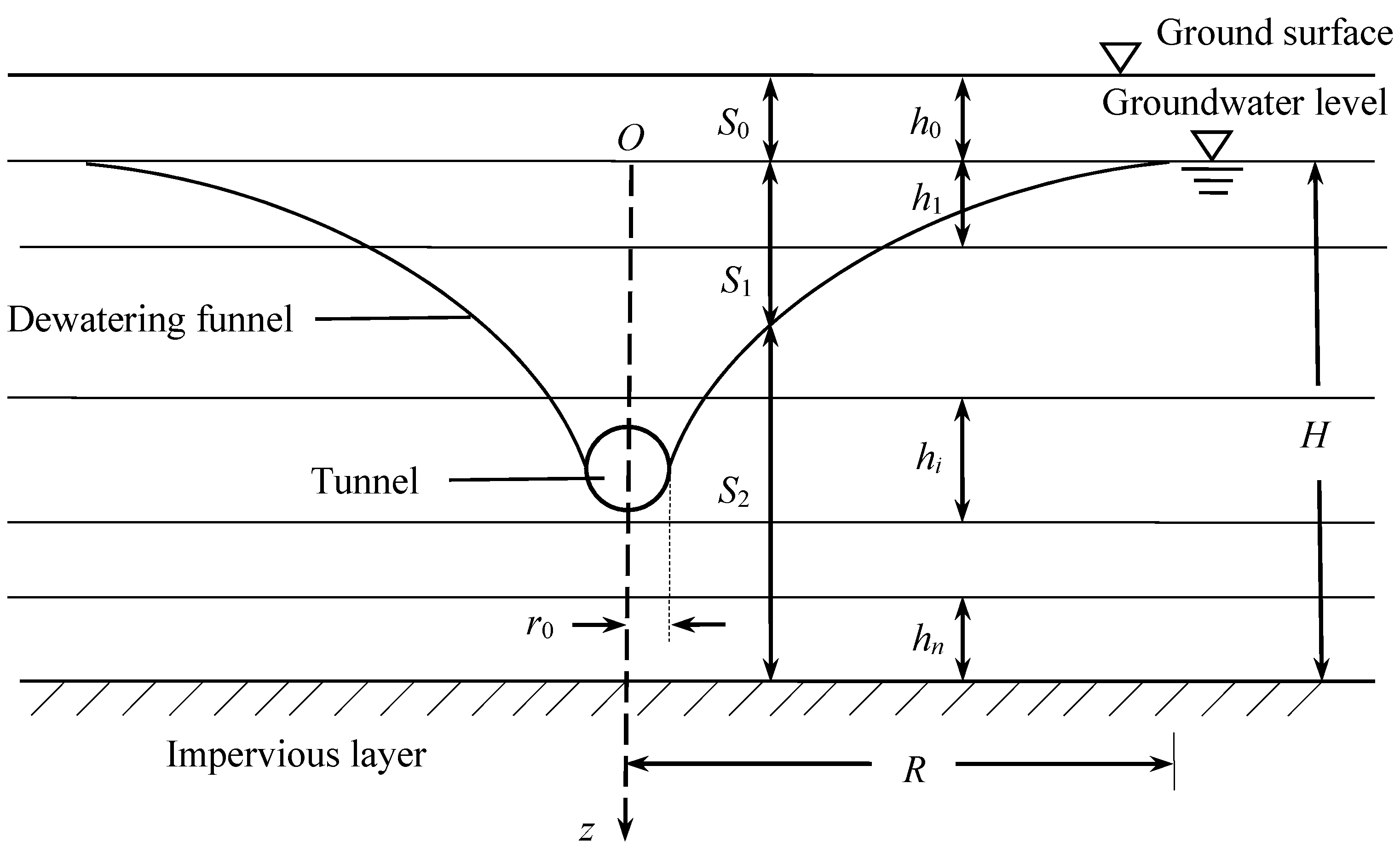
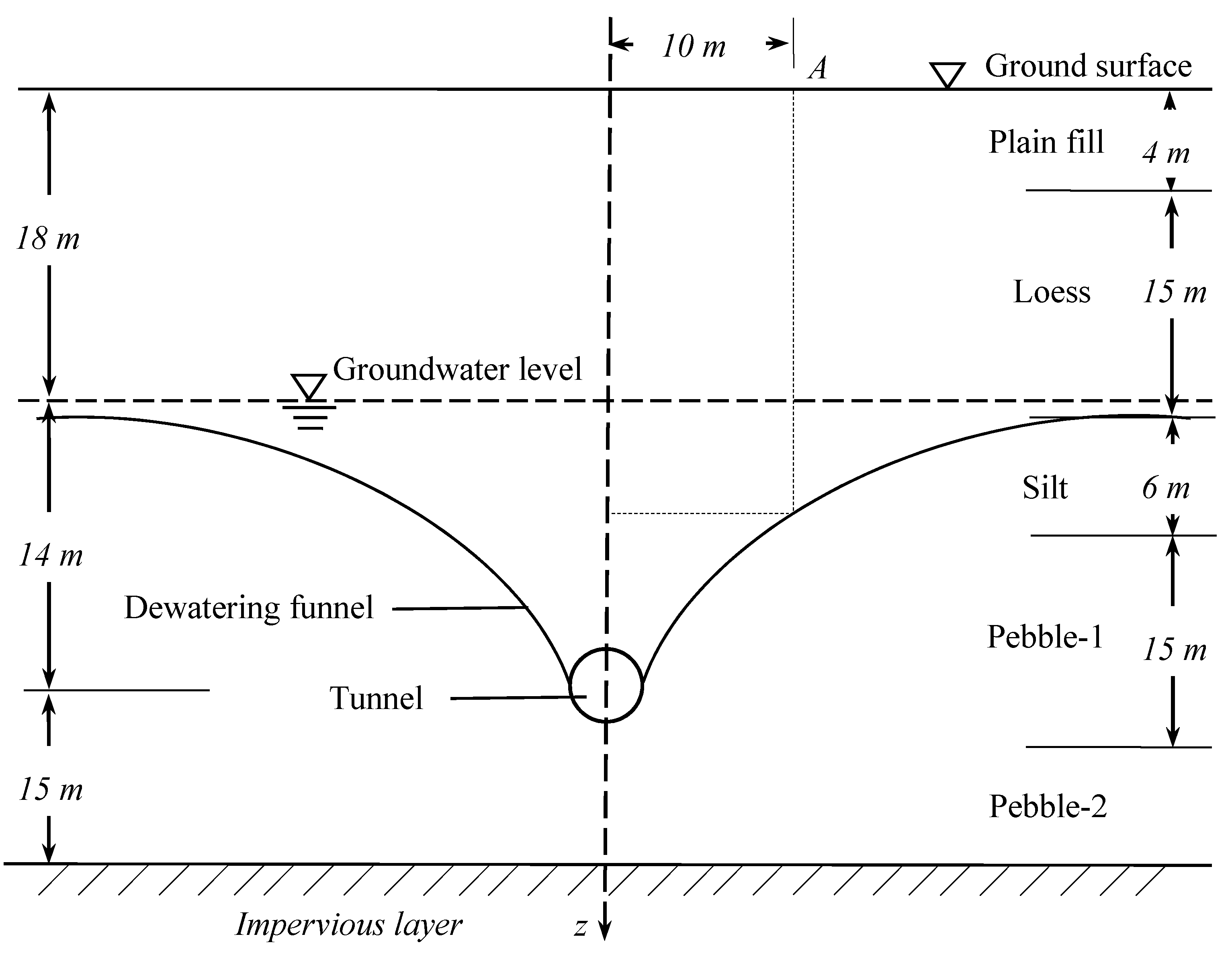
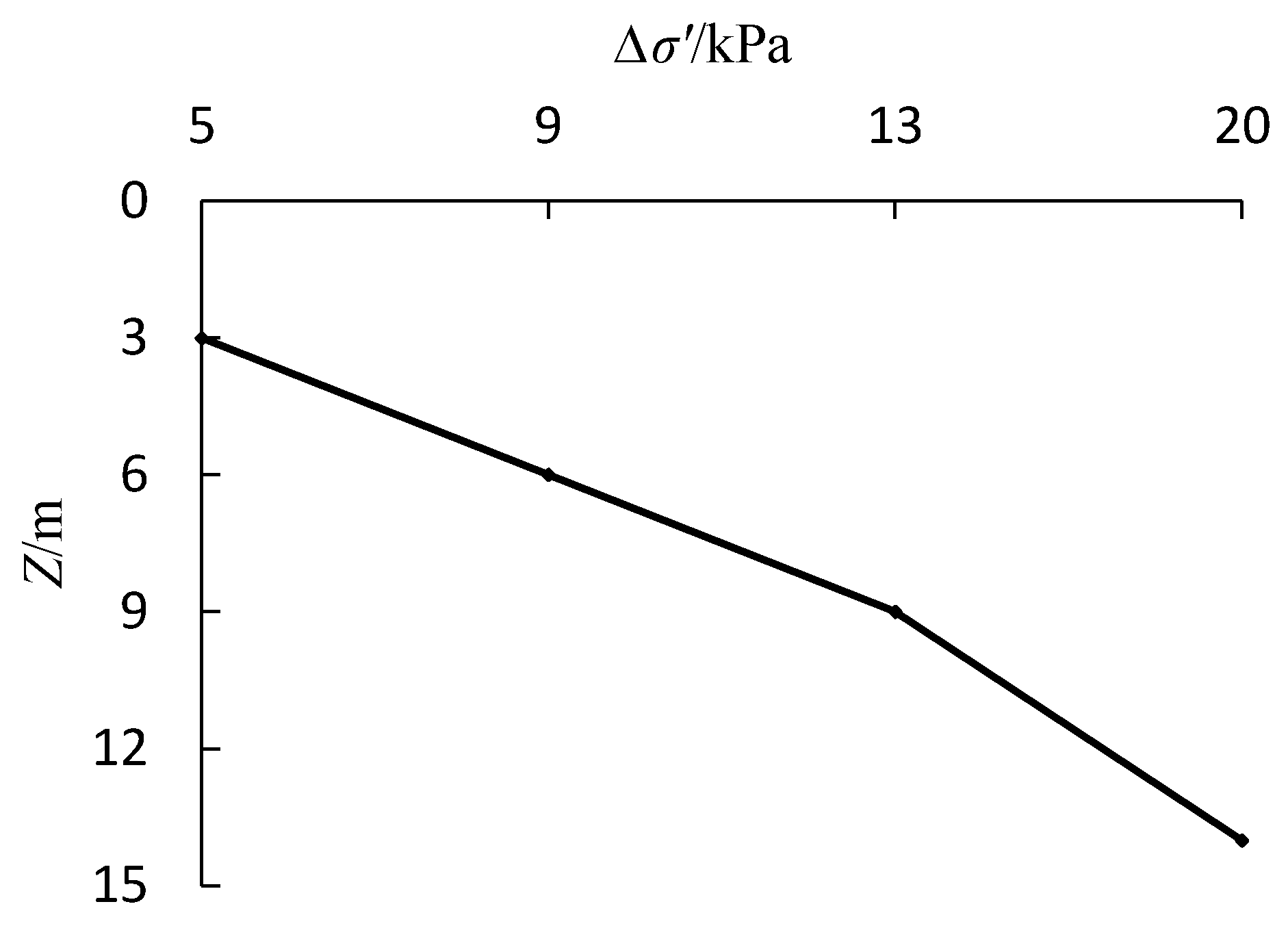
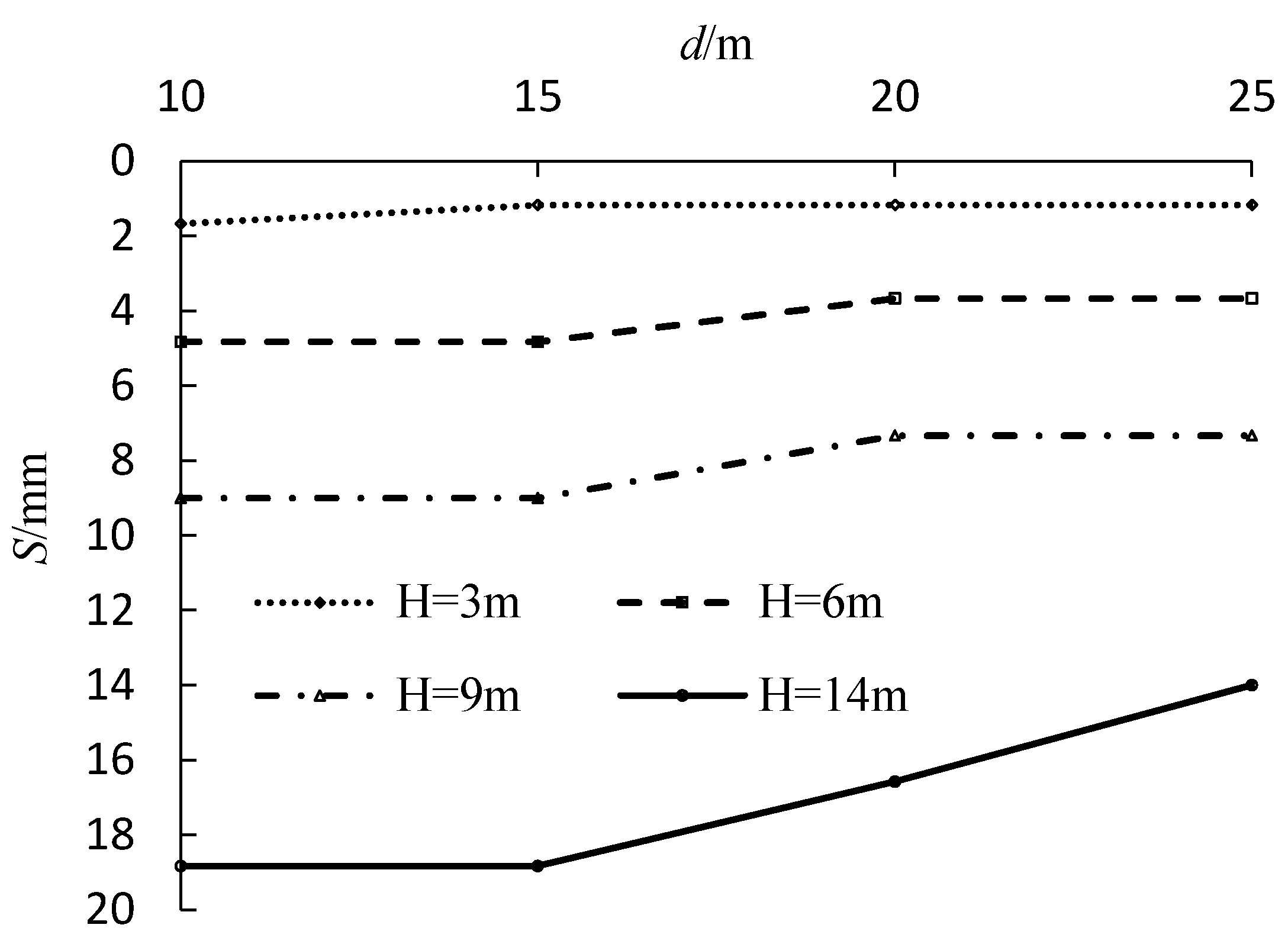
| Soil Types | hi/m | ki/m·d−1 | Ei/MPa | γd/kN·m−3 |
|---|---|---|---|---|
| Plain fill | 4 | — | 8 | 13.1 |
| Loess | 15 | 5 | 10 | 13.5 |
| Silt | 6 | 5 | 30 | 14.7 |
| Pebble-1 | 15 | 60 | 40 | 21.4 |
| Pebble-2 | >200 | 60 | 60 | 22.7 |
Publisher’s Note: MDPI stays neutral with regard to jurisdictional claims in published maps and institutional affiliations. |
© 2021 by the authors. Licensee MDPI, Basel, Switzerland. This article is an open access article distributed under the terms and conditions of the Creative Commons Attribution (CC BY) license (http://creativecommons.org/licenses/by/4.0/).
Share and Cite
Wei, Z.; Zhu, Y. A Theoretical Calculation Method of Ground Settlement Based on a Groundwater Seepage and Drainage Model in Tunnel Engineering. Sustainability 2021, 13, 2733. https://doi.org/10.3390/su13052733
Wei Z, Zhu Y. A Theoretical Calculation Method of Ground Settlement Based on a Groundwater Seepage and Drainage Model in Tunnel Engineering. Sustainability. 2021; 13(5):2733. https://doi.org/10.3390/su13052733
Chicago/Turabian StyleWei, Zhengde, and Yanpeng Zhu. 2021. "A Theoretical Calculation Method of Ground Settlement Based on a Groundwater Seepage and Drainage Model in Tunnel Engineering" Sustainability 13, no. 5: 2733. https://doi.org/10.3390/su13052733
APA StyleWei, Z., & Zhu, Y. (2021). A Theoretical Calculation Method of Ground Settlement Based on a Groundwater Seepage and Drainage Model in Tunnel Engineering. Sustainability, 13(5), 2733. https://doi.org/10.3390/su13052733





